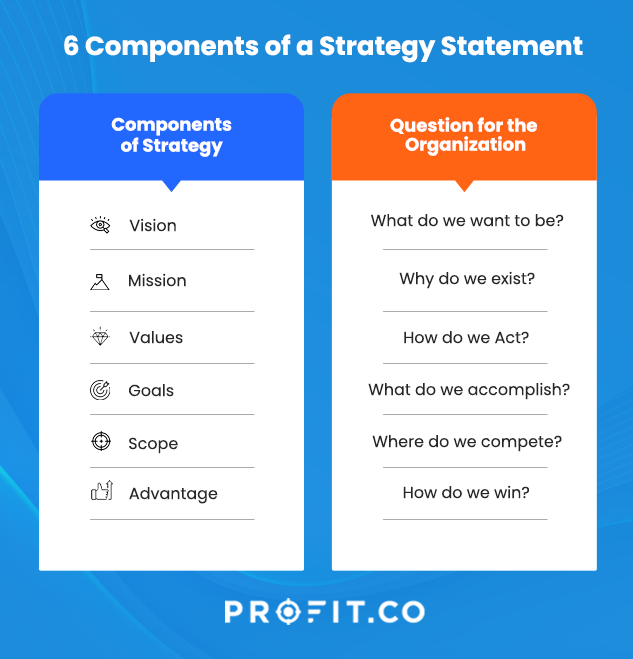The term “strategy” has a compelling history that enriches its contemporary meaning. According to John Adair in Effective Strategic Leadership: The Ultimate Guide to Strategic Management, the word is derived from the ancient Greek word “Stratos,” which refers to an army or a large body of people. The suffix “-egy” originates from a Greek verb meaning “to lead.” This etymology transports us to the era of warfare, highlighting the military leaders or generals who employed strategic approaches to outmaneuver and defeat rival forces.
In those times, the general, leading the ‘Stratos,’ was responsible for both the collective army and its components. Their success in historic battles was often attributed to their mastery of strategy, a quality deemed indispensable for any leader. This historical perspective on strategy lays the foundation for understanding its application in strategic management, particularly in strategic leadership.
This historical backdrop allows us to explore how strategic management unfolds through effective strategic leadership. This blog will delve into how the principles of strategy, rooted in ancient military tactics, are now integral to guiding modern businesses toward success. By aligning strategic leadership with organizational goals, companies can navigate complex markets, adapt to changing environments, and achieve sustainable growth. Let’s explore this intriguing journey from ancient battlefields to boardrooms, understanding how strategic management shapes the landscape of contemporary business.
Those having torches will pass them on to others.
What is Strategic Management?
A Forbes article highlights a crucial insight for modern businesses: “Last Year’s Strategic Plans Likely Won’t Work In 2024.” This statement underscores the dynamic nature of today’s business environment, suggesting that strategies successful in the past may not be effective in the future. It emphasizes the need for companies to constantly re-evaluate and innovate their strategies to ensure continued success and growth. To achieve this, organizations must diligently assess various factors, including cost cuts, talent acquisition costs, and the implications of minor adjustments or ‘micro cuts’ in their operations.
This necessity for continual strategic innovation brings us to the core concept of strategic management. Strategic management is a systematic process of planning, managing, and allocating resources to efficiently define and achieve organizational objectives. It’s not just about internal processes but also involves a keen analysis of external factors that can impact the business. Organizations can gain a competitive edge through strategic management, enhance performance, and adapt to the ever-changing business landscape.
The origins of the term ‘strategic management’ and its practice can be traced back to the pioneering work of Harry Igor Ansoff, a Russian-American applied mathematician and business manager. Ansoff is widely regarded as the “father of strategic management,” most notably for his development of the Ansoff Matrix. This strategic planning tool has been fundamental in aiding businesses in determining their product and market growth strategies. Ansoff’s innovative thinking and seminal contributions have profoundly influenced how organizations approach strategy formulation and decision-making. His frameworks continue to offer valuable insights for analyzing and capitalizing on business growth opportunities in various market conditions.
In essence, the evolution of strategic management, as championed by Ansoff, combined with the current business landscape’s dynamic nature, as highlighted by the Forbes article, illustrates the importance of continuous strategic reassessment and innovation in today’s corporate world.
Following Ansoff’s revolutionary concept, various methodologies and approaches have emerged, aiding countless organizations in achieving remarkable success. As the business world continues to evolve, so must strategic approaches. Understanding this progression is key to grasping the essence and importance of strategic management in today’s business landscape. It’s a continuous journey of adaptation and reinvention, where the ability to anticipate and respond to change is as crucial as the strategies themselves.
What is the Importance of Strategic Management?
Strategic management is essential for guiding organizations toward long-term success. It involves setting clear objectives, analyzing competitive environments, and implementing plans to achieve these goals efficiently. This process allows businesses to adapt to market changes and leverage opportunities while also identifying and mitigating potential risks. Ultimately, strategic management ensures sustained growth and competitive advantage in an ever-evolving business landscape.
Lead your organization with confidence using Profit.co.
Understanding Strategic Management
Understanding Strategic Management involves delving into the art of crafting, implementing, and evaluating cross-functional decisions that enable an organization to achieve its long-term objectives. It’s a comprehensive process that integrates an organization’s mission, vision, and goals into a cohesive plan for future success. Strategic management encompasses various perspectives, each with its unique focus and methodology.
2 Types of strategic approaches
There are two primary approaches: prescriptive and descriptive.
1. Prescriptive Approach
The prescriptive approach is concerned with how strategies ought to be formulated. It emphasizes a systematic process of analyzing all potential threats and opportunities before making strategic decisions. It involves rigorous analysis and planning before any implementation. Prescriptive strategies are based on thorough market research, forecasting, and long-term vision.
2. Descriptive Approach
In contrast, the descriptive approach concentrates on how strategies are actually implemented in practice, viewing them as broad principles that guide organizational decision-making. This approach is less formal and structured, focusing more on learning and adapting as situations evolve. It’s particularly useful in dynamic and fast-changing environments where it’s difficult to predict long-term trends.
Why Understand Strategic Management?
The culture of a business, the skills and competencies of its workforce, and the structure of the organization are crucial elements that impact the achievement of its goals. Organizations with rigid structures may struggle to adapt and thrive in a dynamic business environment. Moreover, a disconnect between strategy formulation and strategy execution can create challenges for managers in assessing the effectiveness and efficiency of their strategic objectives.
Responsibility for an organization’s strategy typically lies with its upper management. However, strategic ideas and initiatives often originate from lower-level managers and employees. This approach underscores the importance of a collaborative strategy development process, where an organization might employ a team of individuals dedicated to strategic planning with a good swot analysis, rather than relying solely on the CEO for direction. This inclusive approach to strategy allows for a diverse range of insights and ideas, contributing to more robust and effective strategic planning.
Discussing strategy inevitably leads to the crucial aspect of its execution. While strategizing is a key component of any effective strategic plan, effectively executing these strategies is equally important. In today’s fast-paced and ever-changing industry landscape, having the right tools to efficiently implement strategies is vital. One such tool that stands out in facilitating this process is Profit.co.
Profit.co offers an innovative platform specifically designed for OKR (Objectives and Key Results) planning, review, and execution. OKRs are a goal-setting framework originally developed by Intel and have been widely adopted for their effectiveness in defining, measuring, and tracking outcomes. The strength of Profit.co’s OKR system lies in its ability to seamlessly bridge the gap between strategy planning and its execution. It provides a clear, measurable, and structured way to align goals across an organization.
This platform not only assists in setting and achieving objectives but also plays a significant role in cultivating a culture of innovation, collaboration, and accountability. With features like regular check-ins and feedback mechanisms, Profit.co encourages continuous learning and adaptability within teams. These functionalities make Profit.co’s OKRs are an indispensable tool in strategic management, ensuring that businesses remain focused and agile in achieving their objectives amidst the dynamic demands of their respective industries.
Components of a Strategy Statement
Components of a strategy statement are the essential elements that define and communicate the strategic direction and purpose of an organization. They help align the organization’s actions and decisions with its vision, mission, values, goals, and competitive advantage.
Components of a strategy statement usually include the following:
Vision and mission statements are important elements of the strategic planning process for any organization. They help define the organization’s purpose, goals, and direction, as well as communicate its values and aspirations to internal and external stakeholders. They also guide the decision-making process and align the resources and actions of the organization toward achieving its desired future.

Vision
This is the aspirational and inspirational statement that describes the desired future state of the organization. It answers the question, “What do we want to be?” For example, Microsoft’s vision is “to empower people through great software, any time, any place, or any device.
Some of the features of a vision in strategic management are:
- Future-focused: It describes the desired state of the organization in the next 5 to 10 years or more. It reflects the organization’s values and purpose and how it will create value for its customers, employees, and society.
- Directional: It sets the overall course of the organization and guides its strategic decisions and actions. It helps the organization align its resources and capabilities with its goals and opportunities.
- Clear: It is concise, specific, and easy to understand. It communicates the essence of the organization and what makes it unique and competitive. It avoids vague or generic statements that could apply to any organization.
- Feasible: It is realistic and attainable. It considers the current and future environment and the strengths and weaknesses of the organization. It challenges the organization to stretch its potential but does not set unrealistic or impossible expectations.
- Value-based: It reflects the core values and principles of the organization and its stakeholders. It expresses the organization’s social responsibility and ethical standards. It builds trust and credibility with the internal and external audiences.
- Challenging: It inspires the organization to pursue excellence and innovation. It encourages the organization to take risks and explore new possibilities. It fosters a culture of learning and continuous improvement.
- Inspiring: It motivates and energizes the organization and its stakeholders to work towards a common vision. It creates a sense of ownership and commitment among the employees and other partners. It generates enthusiasm and excitement for the future.
Mission
This is the statement that defines the core purpose and reason for the existence of the organization. It answers the question, “Why do we exist?” For example, Wal-Mart’s mission is “To give ordinary folk the chance to buy the same thing as rich people. Some of the features of a mission in strategic management are:
- Purposeful: It defines the reason why the organization exists and what it aims to achieve. It reflects the organization’s values and principles and how it serves its customers, employees, and society.
- Broad: It covers the scope of the organization’s operations in terms of products, markets, and technologies. It does not limit the organization’s potential or opportunities but allows flexibility and adaptability.
- Inspiring: It motivates and energizes the organization and its stakeholders to work towards a common mission. It creates a sense of ownership and commitment among the employees and other partners. It generates enthusiasm and excitement for the present and the future.
- Distinctive: It differentiates the organization from its competitors and creates a distinctive identity and image. It captures the organization’s competitive advantage and core competencies. It appeals to the emotions and passions of the organization and its stakeholders.
- Indicative: It indicates the major components of the strategy and how the objectives are to be accomplished. It provides direction and guidance for the strategic decisions and actions. It helps the organization align its resources and capabilities with its goals and opportunities.
Values
These are the principles and beliefs that guide the behavior and culture of the organization. They answer the question, “How do we act?” For example, Google’s values include “Focus on the user and all else will follow,” “Democracy on the web works,” and “You can be serious without a suit.
Goals
These are the specific, measurable, achievable, relevant, and time-bound (SMART) outcomes and targets the organization aims to achieve. They answer the question, “What do we want to accomplish?” For example, Tesla’s goals include “Accelerate the world’s transition to sustainable energy” and “; Produce 500,000 vehicles per year by 2020.
Scope
This is the statement that defines the boundaries and focus of the organization in terms of the products, markets, and customers it serves. It answers the question, “Where do we compete?” For example, Starbucks’ scope is “to inspire and nurture the human spirit – one person, one cup, and one neighborhood at a time.
Competitive advantage
This is the statement that describes the unique value proposition and differentiation of the organization from its competitors. It answers the question, “How do we win?” For example, Amazon’s competitive advantage is “to be Earth’s most customer-centric company, where customers can find and discover anything they might want to buy online, and endeavors to offer its customers the lowest possible prices.”
The Strategic Management Process
The strategic management process is how organizations plan, analyze, and execute their strategies to achieve their goals and objectives. To gain a deeper comprehension of strategic management, it’s essential to examine its various approaches and types, tailored to suit different situations and desired outcomes. Exploring these five diverse methodologies highlights the numerous benefits strategic management can offer, including
The 5 Phases of Strategic Management That Every Company Should Know
Strategic management is a crucial process for any organization, guiding it toward achieving long-term goals and adapting to a constantly changing environment. Here are the five key phases of strategic management that every company should be aware of:
1. Goal setting
The initial step for an organization is to define clear and achievable goals. These goals should clarify what the company aims to accomplish and the reasons behind these ambitions. Once established, the organization can then determine specific objectives that detail how these goals will be attained. This stage is crucial for articulating the company’s vision and setting both long-term and short-term goals.
2. Environmental analysis
Next, organizations must thoroughly assess and understand the internal and external factors influencing their business and objectives. This includes evaluating what is necessary to stay competitive. Tools like SWOT analysis are particularly useful in this phase for gaining insights into strengths, weaknesses, opportunities, and threats.
3. Strategy formulation
After analyzing various factors, the company can formulate its strategy, define the means to achieve its goals. This stage involves identifying necessary resources (such as people and technology), allocating these resources effectively, and establishing performance metrics to gauge success. Securing support from stakeholders and business leaders is also a vital part of this process.
4. Strategy implementation
The fourth step involves putting the planned strategies into action or strategy implementation. This phase sees the mobilization of allocated resources, each playing their role as per the defined responsibilities and tasks.
5. Strategy evaluation and adjustment
The final stage involves evaluating the effectiveness of the implemented strategies using the pre-established metrics. The organization should assess whether any strategies are underperforming and consider replacing them with more effective ones. Continuous monitoring of both the external business environment and internal operations is essential, as is the ongoing adaptation and refinement of successful strategies.
Final Thoughts
The process of strategic management involves aligning a company’s resources with its goals and objectives. Different approaches to strategic management exist, ranging from prescriptive to descriptive, but most businesses use a combination of both. Strategic management helps companies define their vision, gain a competitive advantage, optimize their resources, and more. There is no one-size-fits-all solution. Companies need to design and adapt a strategic management process that suits their needs and their customers. Strategic management is not a one-time activity, but a continuous process that evolves with the business.

